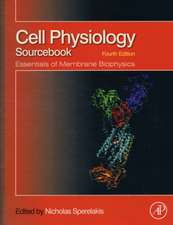Hydrogen Bonding in Biological Structures
Autor George A. Jeffrey, Wolfram Saengeren Limba Engleză Paperback – 27 mai 1994
Hydrogen Bonding in Biological Structures is informative and eminently usable. It is, in a sense, a Rosetta stone that unlocks a wealth of information from the language of crystallography and makes it accessible to all scientists. (From a book review of Kenneth M. Harmon, Science 1992)
Preț: 654.43 lei
Preț vechi: 769.92 lei
-15% Nou
Puncte Express: 982
Preț estimativ în valută:
125.24€ • 129.38$ • 104.23£
125.24€ • 129.38$ • 104.23£
Carte tipărită la comandă
Livrare economică 26 martie-09 aprilie
Preluare comenzi: 021 569.72.76
Specificații
ISBN-13: 9783540579038
ISBN-10: 3540579036
Pagini: 584
Ilustrații: XIV, 569 p. 23 illus.
Dimensiuni: 155 x 235 x 31 mm
Greutate: 0.81 kg
Ediția:Softcover reprint of the original 1st ed. 1994
Editura: Springer Berlin, Heidelberg
Colecția Springer
Locul publicării:Berlin, Heidelberg, Germany
ISBN-10: 3540579036
Pagini: 584
Ilustrații: XIV, 569 p. 23 illus.
Dimensiuni: 155 x 235 x 31 mm
Greutate: 0.81 kg
Ediția:Softcover reprint of the original 1st ed. 1994
Editura: Springer Berlin, Heidelberg
Colecția Springer
Locul publicării:Berlin, Heidelberg, Germany
Public țintă
ResearchCuprins
IA Basic Concepts.- 1 The Importance of Hydrogen Bonds.- 2 Definitions and Concepts.- 3 Experimental Studies of Hydrogen Bonding.- 4 Theoretical Calculations of Hydrogen-Bond Geometries.- 5 Effect of Hydrogen Bonding on Molecular Structure.- IB Hydrogen-Bond Geometry.- 6 The Importance of Small Molecule Structural Studies.- 7 Metrical Aspects of Two-Center Hydrogen Bonds.- 8 Metrical Aspects of Three- and Four-Center Hydrogen Bonds.- 9 Intramolecular Hydrogen Bonds.- 10 Weak Hydrogen-Bonding Interactions Formed by C-H Groups as Donors and Aromatic Rings as Acceptors.- 11 Halides and Halogen Atoms as Hydrogen-Bond Acceptors.- 12 Hydrogen-Bond Acceptor Geometries.- II Hydrogen Bonding in Small Biological Molecules.- 13 Hydrogen Bonding in Carbohydrates.- 14 Hydrogen Bonding in Amino Acids and Peptides: Predominance of Zwitterions.- 15 Purines and Pyrimidines.- 16 Base Pairing in the Purine and Pyrimidine Crystal Structures.- 17 Hydrogen Bonding in the Crystal Structures of the Nucleosides and Nucleotides.- III Hydrogen Bonding in Biological Macromolecules.- 18 O-H ··· O Hydrogen Bonding in Crystal Structures of Cyclic and Linear Oligoamyloses: Cyclodextrins, Maltotriose, and Maltohexaose.- 19 Hydrogen Bonding in Proteins.- 20 The Role of Hydrogen Bonding in the Structure and Function of the Nucleic Acids.- IV Hydrogen Bonding by the Water Molecule.- 21 Hydrogen-Bonding Patterns in Water, Ices, the Hydrate Inclusion Compounds, and the Hydrate Layer Structures.- 22 Hydrates of Small Biological Molecules: Carbohydrates, Amino Acids, Peptides, Purines, Pyrimidines, Nucleosides and Nucleotides.- 23 Hydration of Proteins.- 24 Hydration of Nucleic Acids.- 25 The Role of Three-Center Hydrogen Bonds in the Dynamics of Hydration and of Structure Transition.- References.-Refcodes.








